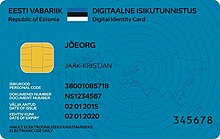
Back Электроннае рэзыдэнцтва Эстоніі BE-X-OLD Естонско електронно жителство Bulgarian E-Residencia de Estonia Spanish E-residentsus Estonian Viron e-asukas Finnish E-résidence de l'Estonie French E-residency estone Italian 에스토니아 전자영주권 Korean Igaunijas e-rezidentūra Latvian/Lettish Электронная резиденция Russian

e-Residency of Estonia (also called virtual residency or E-residency) is a program launched by Estonia on 1 December 2014. The program allows non-Estonians access to Estonian services such as company formation, banking, payment processing, and taxation. The program gives the e-resident a smart card which they can use to sign documents. The program is aimed towards location-independent entrepreneurs such as software developers and writers. The first e-resident of Estonia was British journalist Edward Lucas; the first person to apply for and be granted e-residency through the standard process was Hamid Tahsildoost from the United States.[1][2][3][4]
- ^ "President Ilves annab täna üle esimese e-residendi kaardi" (in Estonian). Estonian Development Foundation. 1 December 2014. Archived from the original on 6 February 2015. Retrieved 6 February 2015.
- ^ Eesti avab 2014. aasta lõpus oma e-teenused ülejäänud maailmale Archived 19 January 2015 at the Wayback Machine Majandus- ja kommunikatsiooniministeerium (in Estonian) (Accessed on 6 February 2015)
- ^ Milliste hüvede osaliseks saab Eesti esimene e-resident Edward Lucas? Eesti Päevaleht, 29 November 2014 (in Estonian) (Accessed on 6 February 2015)
- ^ "E-residency – up against great expectations". E-Estonia.com. 13 January 2015. Archived from the original on 6 February 2015. Retrieved 6 February 2015.